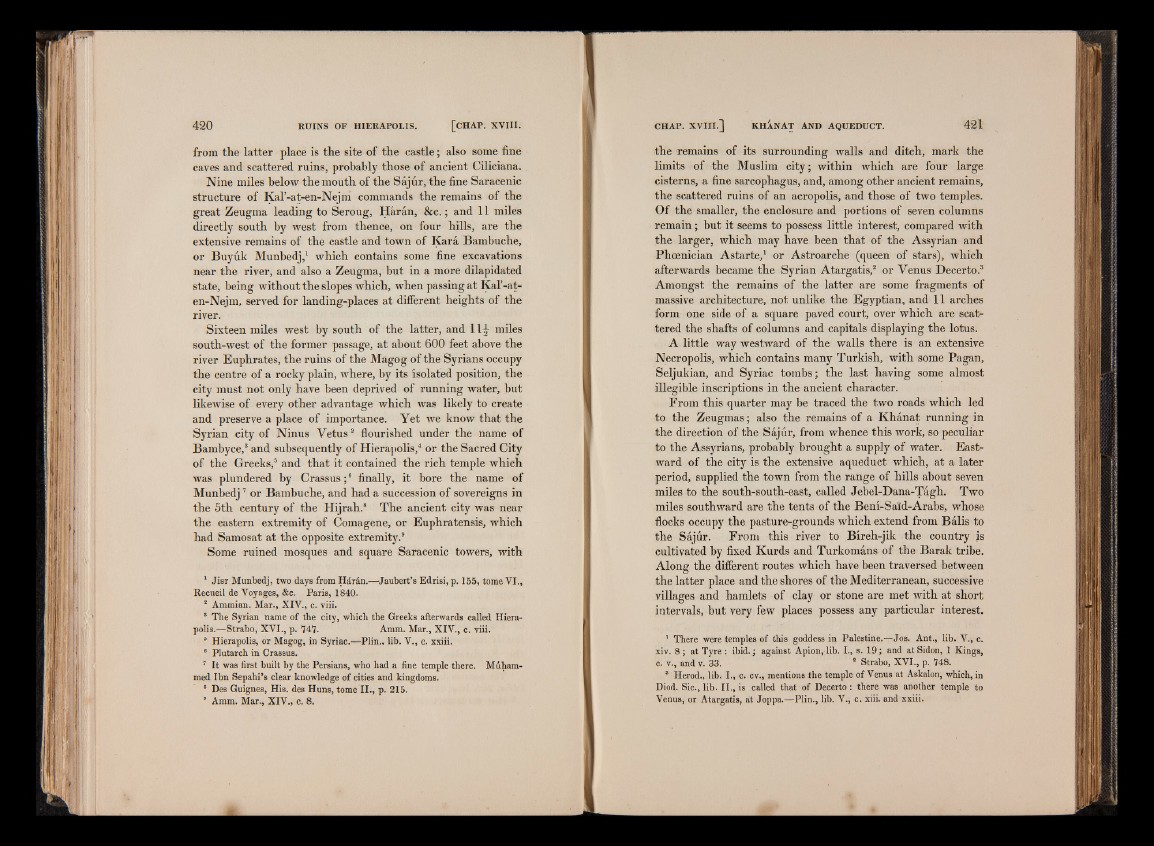
from the latter place is the site of the castle; also some fine
caves and scattered ruins, prohahly those of ancient Ciliciana.
Nine miles below the mouth of the Sájúr, the fine Saracenic
structure of Kal’-at-en-Nejni commands the remains of the
great Zeugma leading to Seroug, Harán, &c.; and 11 miles
directly south by west from thence, on four hills, are the
extensive remains of the castle and town of Kara Bambuche,
or Buyúk Munbedj,1 which contains some fine excavations
near the river, and also a Zeugma, hut in a more dilapidated
state, being without the slopes which, when passing at Kal’-at-
en-Nejm, served for landing-places at different heights of the
river.
Sixteen miles west by south of the latter, and 11J miles
south-west of the former passage, at about 600 feet above the
river Euphrates, the ruins of the Magog of the Syrians occupy
the centre of a rocky plain, where, by its isolated position, the
city must not only have been deprived of running water, but
likewise of every other advantage which was likely to create
and preserve a place of importance. Yet we know that the
Syrian city of Ninus Vetus2 flourished under the name of
Bambyce,3 and subsequently of Hierapolis,4 or the Sacred City
of the Greeks,5 and that it contained the rich temple which
was plundered by Crassus;6 finally, it bore the name of
Munbedj7 or Bambuche, and had a succession of sovereigns in
the 5th century of the Hijrah.8 The ancient city was near
the eastern extremity of Comagene, or Euphratensis, which
had Samosat at the opposite extremity.9
Some ruined mosques and square Saracenic towers, with
1 Jisr Munbedj, two days from Hárán.—Jaubert’s Edrisi, p. 155, tome VI.,
Recueil de Voyages, &c. Paris, 1840.
8 Ammian. Mar., XIV., c. viii.
3 The Syrian name of the city, which the Greeks afterwards called Hierapolis.—
Strabo, XVI., p. 147. Amm. Mar., XIV., c. viii.
5 Hierapolis, or Magog, in Syriac.—Plin., lib. V., c. xxiii.
8 Plutarch in Crassus.
7 It was first built by the Persians, who had a fine temple there. Mohammed
Ibn Sepahi’s clear knowledge of cities and kingdoms.
8 Des Guignes, His. des Huns, tome II., p. 215.
' Amm. Mar., XIV., c. 8.
the remains of its surrounding walls and ditch, mark the
limits of the Muslim city; within which are four large
cisterns, a fine sarcophagus, and, among other ancient remains,
the scattered ruins of an acropolis, and those of two temples.
Of the smaller, the enclosure and portions of seven columns
remain; but it seems to possess little interest, compared with
the larger, which may have been that of the Assyrian and
Phoenician Astarte,1 or Astroarche (queen of stars), which
afterwards became the Syrian Atargatis,2 or Yenus Decerto.3
Amongst the remains of the latter are some fragments of
massive architecture, not unlike the Egyptian, and 11 arches
form one side of a square paved court, over which are scattered
the shafts of columns and capitals displaying the lotus.
A little way westward of the walls there is an extensive
Necropolis, which contains many Turkish, with some Pagan,
Seljukian, and Syriac tombs; the last having some almost
illegible inscriptions in the ancient character.
From this quarter may be traced the two roads which led
to the Zeugmas; also the remains of a Khanat running in
the direction of the Sajur, from whence this work, so peculiar
to the Assyrians, probably brought a supply of water. Eastward
of the city is the extensive aqueduct which, at a later
period, supplied the town from the range of hills about seven
miles to the south-south-east, called Jebel-Dana-Tagh. Two
miles southward are the tents of the Beni-Said-Arabs, whose
flocks occupy the pasture-grounds which extend from Balis to
the Sajur. From this river to Bireh-jik the country is
cultivated by fixed Kurds and Turkomans of the Barak tribe.
Along the different routes which have been traversed between
the latter place and the shores of the Mediterranean, successive
villages and hamlets of clay or stone are met with at short
intervals, but very few places possess any particular interest.
1 There were temples of this goddess in Palestine.—Jos. Ant., lib. V., c.
xiv. 8 ; at Tyre : ibid.; against Apion, lib. I., s. 19; and atSidon, 1 Kings,
c. v., and v. 33. 2 Strabo, XVI., p. 148.
3 Herod., lib. I., c. cv., mentions the temple of Venus at Askalon, which, in
Diod. Sic., lib. II., is called that of Decerto : there was another temple to
Venus, or Atargatis, at Joppa.—Plin., lib. V.; c. xiii. and xxiii.